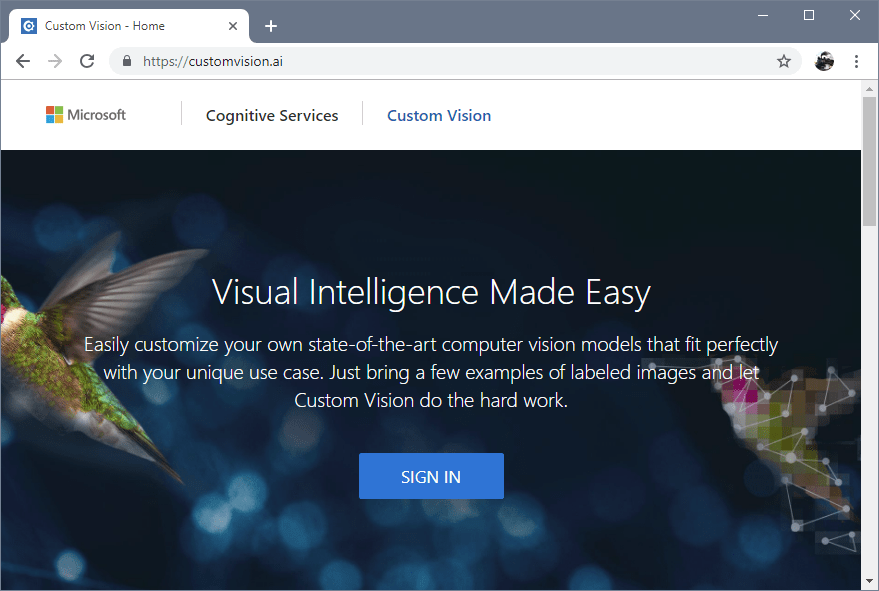Events
May 19, 6 PM - May 23, 12 AM
Calling all developers, creators, and AI innovators to join us in Seattle @Microsoft Build May 19-22.
Register todayThis browser is no longer supported.
Upgrade to Microsoft Edge to take advantage of the latest features, security updates, and technical support.
Azure AI Custom Vision is an image recognition service that lets you build, deploy, and improve your own image identifier models. An image identifier applies labels to images according to their visual characteristics. Each label represents a classification or object. Custom Vision allows you to specify your own labels and train custom models to detect them.
You can use Custom Vision through a client library SDK, REST API, or through the Custom Vision web portal. Follow a quickstart to get started.
This documentation contains the following types of articles:
For a more structured approach, follow a Training module for Custom Vision:
The Custom Vision service uses a machine learning algorithm to analyze images for custom features. You submit sets of images that do and don't have the visual characteristics you're looking for. Then you label the images with your own labels (tags) at the time of submission. The algorithm trains to this data and calculates its own accuracy by testing itself on the same images. Once you've trained your model, you can test, retrain, and eventually use it in your image recognition app to classify images or detect objects. You can also export the model for offline use.
Custom Vision functionality can be divided into two features. Image classification applies one or more labels to an entire image. Object detection is similar, but it returns the coordinates in the image where the applied label(s) are found.
The Custom Vision service is optimized to quickly recognize major differences between images, so you can start prototyping your model with a small amount of data. It's generally a good start to use 50 images per label. However, the service isn't optimal for detecting subtle differences in images (for example, detecting minor cracks or dents in quality assurance scenarios).
Additionally, you can choose from several variations of the Custom Vision algorithm that are optimized for images with certain subject material—for example, landmarks or retail items. For more information, see Select a domain.
The Custom Vision Service is available as a set of native SDKs and through a web-based interface on the Custom Vision portal. You can create, test, and train a model through either interface or use both together.
The Custom Vision portal can be used by the following web browsers:

As a part of Azure, Custom Vision Service has components that are maintained across multiple regions. Service zones and regions are used by all of our services to provide continued service to our customers. For more information on zones and regions, see Azure regions. If you need additional information or have any issues, contact support.
See Limits and quotas for image input limitations.
As with all of the Azure AI services, developers using the Custom Vision service should be aware of Microsoft's policies on customer data. See the Azure AI services page on the Microsoft Trust Center to learn more.
Custom Vision doesn't replicate data outside of the specified region, except for one region, NorthCentralUS, where there is no local Azure Support.
Follow the Build a classifier quickstart to get started using Custom Vision in the web portal.
Events
May 19, 6 PM - May 23, 12 AM
Calling all developers, creators, and AI innovators to join us in Seattle @Microsoft Build May 19-22.
Register todayTraining
Module
Classify images with Azure AI Custom Vision - Training
Explore Azure AI Custom Vision's classification capabilities.
Certification
Microsoft Certified: Azure AI Engineer Associate - Certifications
Design and implement an Azure AI solution using Azure AI services, Azure AI Search, and Azure Open AI.
Documentation
Quickstart: Build an image classification model with the Custom Vision portal - Azure AI services
Learn how to use the Custom Vision web portal to create, train, and test an image classification model.
Quickstart: Build an object detector with the Custom Vision website - Azure AI services
Learn how to use the Custom Vision website to create, train, and test an object detector model.
Quickstart: Image classification with Custom Vision SDK - Azure AI services
Learn how to create an image classification project, add tags, train your project, and make predictions using the Custom Vision client library or the REST API.